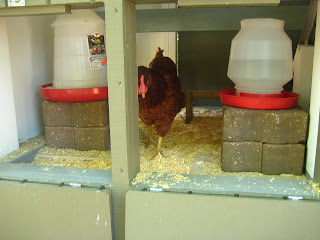The first coop we bought for our chickens was a a fancy little A-frame that we thought would look nice in our yard. The description of the coop clearly stated that it was large enough for three, possibly four, medium-sized hens. As I have done in so many other instances totally unrelated to chickens, I disregarded knowledge and caved in to emotion. Surely, such an attractive little coop could be made to work. We had three medium-sized chickens. The problem was we also had three heavy-breed chickens. By the time the chickens were getting ready to lay, it was obvious that our current set-up would never do. The chickens were falling out of the roosting area, they were having to sleep in the nest, and the weather was beginning to warm up. It would soon be stifling in the small sleeping area. I became concerned about their health--and mine. After all, we are raising the chickens because we want healthy food from healthy animals. There was only one thing to do--get a larger coop. Happy chickens lay eggs, and we wanted happy chickens!
Enter my son-in-law Henry. I am not going to carry on about all of the talents Henry has. I'll focus on this one--he is a master carpenter who works with wood as a way of relieving all of the stresses his real job lays upon him. He saw the need for a new coop, and he offered to build it--bless him! In one weekend he built the coop I have pictured below. On Saturday morning we sat together to draw up a plan, and by Sunday evening it was complete. The girls have been living in it since March, and it has just been a godsend for them and for us.
 |
| We sited the coop between two star magnolia trees. This left little room for a ramp, so we asked the girls to hop on a concrete block to get into the coop. They easily complied. |
 |
| Big Mama Thornton is using one of two nest boxes. The coop has space for four boxes, but two are enough for our six chickens. |
 |
| We are using the two extra nest box spaces as areas to hold water and food. This comes in handy if we are late letting them out in the morning. |
 |
| The clean-out doors are in back of the coop. By designing the coop with the raised part in the back, Harvey (6'2") is able to clean the coop without having to bend over. |
 |
| The chickens' litter is cleaned daily. I don't think any chickens ever had it so good. Their coop is becoming known around the neighborhood as the Chicken Hilton. |
 |
| Laura is coming to check for an empty nest. |
 |
| The morning is a busy time--hens coming and going. |
 |
| Rhoda is taking advantage of her perch to check out the neighborhood. |
 |
| Generally, the hens lay six eggs a day. Six eggs for six chickens. If happy chickens lay eggs, our chickens are definitely happy with their new coop. |
 |
| Thank you, Henry! |















































